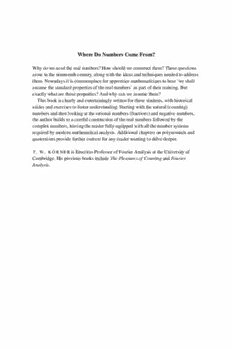Table Of ContentWhereDoNumbersComeFrom?
Whydoweneedtherealnumbers?Howshouldweconstructthem?Thesequestions
aroseinthenineteenthcentury,alongwiththeideasandtechniquesneededtoaddress
them.Nowadaysitiscommonplaceforapprenticemathematicianstohear‘weshall
assumethestandardpropertiesoftherealnumbers’aspartoftheirtraining.But
exactlywhatarethoseproperties?Andwhycanweassumethem?
Thisbookisclearlyandentertaininglywrittenforthosestudents,withhistorical
asidesandexercisestofosterunderstanding.Startingwiththenatural(counting)
numbersandthenlookingattherationalnumbers(fractions)andnegativenumbers,
theauthorbuildstoacarefulconstructionoftherealnumbersfollowedbythe
complexnumbers,leavingthereaderfullyequippedwithallthenumbersystems
requiredbymodernmathematicalanalysis.Additionalchaptersonpolynomialsand
quaternionsprovidefurthercontextforanyreaderwantingtodelvedeeper.
T. W. KÖRNERisEmeritusProfessorofFourierAnalysisattheUniversityof
Cambridge.HispreviousbooksincludeThePleasuresofCountingandFourier
Analysis.
Where Do Numbers Come From?
T. W. KÖRNER
UniversityofCambridge
UniversityPrintingHouse,CambridgeCB28BS,UnitedKingdom
OneLibertyPlaza,20thFloor,NewYork,NY10006,USA
477WilliamstownRoad,PortMelbourne,VIC3207,Australia
314–321,3rdFloor,Plot3,SplendorForum,JasolaDistrictCentre,NewDelhi–110025,
India
79AnsonRoad,#06–04/06,Singapore079906
CambridgeUniversityPressispartoftheUniversityofCambridge.
ItfurtherstheUniversity’smissionbydisseminatingknowledgeinthepursuitof
education,learning,andresearchatthehighestinternationallevelsofexcellence.
www.cambridge.org
Informationonthistitle:www.cambridge.org/9781108488068
DOI:10.1017/9781108768863
(cid:2)c T.W.Körner2020
Thispublicationisincopyright.Subjecttostatutoryexception
andtotheprovisionsofrelevantcollectivelicensingagreements,
noreproductionofanypartmaytakeplacewithoutthewritten
permissionofCambridgeUniversityPress.
Firstpublished2020
PrintedintheUnitedKingdombyTJInternationalLtd.PadstowCornwall
AcataloguerecordforthispublicationisavailablefromtheBritishLibrary.
LibraryofCongressCataloging-in-PublicationData
Names:Korner,T.W.(ThomasWilliam),1946–author.
Title:Wheredonumberscomefrom?/T.W.Korner(UniversityofCambridge).
Description:Cambridge;NewYork,NY:CambridgeUniversityPress,[2020]
Identifiers:LCCN2019020770|ISBN9781108488068
Subjects:LCSH:Numbertheory.|Mathematics–Philosophy.
Classification:LCCQA241.K66972020|DDC512.7–dc23
LCrecordavailableathttps://lccn.loc.gov/2019020770
ISBN978-1-108-48806-8Hardback
ISBN978-1-108-73838-5Paperback
Additionalresourcesforthispublicationatwww.cambridge.org/9781108488068.
CambridgeUniversityPresshasnoresponsibilityforthepersistenceoraccuracyof
URLsforexternalorthird-partyinternetwebsitesreferredtointhispublication
anddoesnotguaranteethatanycontentonsuchwebsitesis,orwillremain,
accurateorappropriate.
Senselessasbeasts,Igavemensense,possessedthem
Ofmind.Ispeaknotincontemptofman;
IdobuttellofgoodgiftsIconferred.
Inthebeginning,seeingtheysawamiss,
Andhearingheardnot,but,likephantomshuddled
Indreams,theperplexedstoryoftheirdays
Confounded;knowingneithertimber-work
Norbrick-builtdwellingsbaskinginthelight,
Butdugforthemselvesholes,whereinlikeants,
Thathardlymaycontendagainstabreath,
Theydweltinburrowsoftheirunsunnedcaves.
Neitherofwinter’scoldhadtheyfixedsign,
Norofthespringwhenshecomesdeckedwithflowers,
Noryetofsummer’sheatwithmeltingfruits
Suretoken:bututterlywithoutknowledge
Moiled,untilItherisingofthestars
Showedthem,andwhentheyset,thoughmuchobscure.
Moreover,number,themostexcellent
Ofallinventions,Iforthemdevised,
Andgavethemwritingthatretainethall,
TheserviceablemotheroftheMuse.
Aeschylus,PrometheusBound,translationbyG.M.Cookson
Whatwouldlifebewithoutarithmeticbutasceneofhorrors.
SydneySmith,lettertoMissLucieAustin
God made the integers, all else is the work of man. (Die ganzen Zahlen
hatderliebeGottgemacht,allesandereistMenschenwerk.)
Kroneckecker,reportedbyWeber,JahresberichtderDeutschen
Mathematiker-Vereinigung(1893)
‘When I use a word,’ Humpty Dumpty said in rather a scornful tone, ‘it
meansjustwhatIchooseittomean–neithermorenorless.’
‘Thequestionis,’saidAlice,‘whetheryoucanmakewordsmeansomany
differentthings.’‘Thequestionis,’saidHumptyDumpty,‘whichistobe
master–thatisall.’
LewisCarroll,AlicethroughtheLooking-Glass
Weshouldneverforgetthatthefunctions,likeallmathematicalconstruc-
tions,areonlyourowncreations,andthatwhenthedefinition,fromwhich
onebegins,ceasestomakesense,oneshouldnotask:whatisit,butwhat
isitconvenienttoassumesothatIcanalwaysremainconsistent.Thusfor
example,theproductofminusbyminus.
CarlFriedrichGauss,lettertoFriedrichBessel,1811,
Volume10ofhiscollectedworks
I have learnt one thing from my Arab masters, with reason as guide,
but you another [from your teachers in Paris]: you follow a halter, being
enthralledbythepictureofauthority.Forwhatelsecanauthoritybecalled
other than a halter? As brute animals are led wherever one pleases by a
halter,butdonotknowwhereorwhytheyarebeingled,andonlyfollow
theropebywhichtheyarepulledalong,sotheauthorityofwrittenwords
leadsmanypeopleintodanger,sincetheyjustacceptwhattheyaretold,
without question. So what is the point of having a brain, if one does not
thinkforoneself?
AdelardofBath,ConversationswithHisNephew(Adelardwasoneof
thosewhointroducedtheIndiansystemofwritingnumberstoEurope.)
Nowyoumayask,‘Whatismathematicsdoinginaphysicslecture?’We
haveseveralpossibleexcuses:first,ofcourse,mathematicsisanimportant
tool,butthatwouldonlyexcuseusforgivingtheformulaintwominutes.
Ontheotherhand,intheoreticalphysicswediscoverthatallourlawscan
bewritteninmathematicalform;andthatthishasacertainsimplicityand
beautyaboutit.So,ultimately,inordertounderstandnatureitmaybenec-
essarytohaveadeeperunderstandingofmathematicalrelationships.But
therealreasonisthatthesubjectisenjoyable,andalthoughwehumanscut
nature up in different ways, ...we should take our intellectual pleasures
wherewefindthem.
RichardFeynman,AdditionandMultiplication,Section22-1ofthe
FeynmanLecturesofPhysics,Volume1
Theveryimportantpartplayedbycalculationinmodernmathematicsand
physics has led to the popular idea of a mathematician as a calculator,
far more expert, indeed, than any banker’s clerk, but, of course, immea-
surably inferior, both in resources and accuracy, to what the ‘analytic
engine’willbe,ifthelateMrBabbage’sdesignshouldeverbecarriedinto
execution.
Butalthoughmuchoftheroutineworkofamathematicianiscalculation,
his proper work – that which constitutes him a mathematician – is the
inventionofmethods.
ClerkMaxwell,reviewofKellandandTait’s
IntroductiontoQuaternionsinNature,1873
There is no excellent beauty that hath not some strangeness in the
proportion.
FrancisBacon,Essays
Havenothinginyourhousesthatyoudonotknowtobeuseful,orbelieve
tobebeautiful.
WilliamMorris,HopesandFearsforArt
Mathematicalrigourisverysimple.Itconsistsinaffirmingtruestatements
andinnotaffirmingwhatisnottrue.Itdoesnotconsistinaffirmingevery
truthpossible.
GiuseppePeano,quotedinDictionaryofScientificBiography
Therearestillpeoplewholiveinthepresenceofaperpetualmiracleand
arenotastonishedbyit.
HenriPoincaré,TheValueofScience
Itseemstome,thattheonlyobjectsoftheabstractsciencesorofdemon-
strationarequantityandnumber,andthatallattemptstoextendthismore
perfectspeciesofknowledgebeyondtheseboundsaremeresophistryand
illusion.Asthecomponentpartsofquantityandnumberareentirelysimi-
lar,theirrelationsbecomeintricateandinvolved;andnothingcanbemore
curious, as well as useful, than to trace, by a variety of mediums, their
equalityorinequality,throughtheirdifferentappearances.
DavidHume,AnEnquiryConcerningHumanUnderstanding
Contents
Introduction 1
PART I THE RATIONALS 5
1 CountingSheep 7
1.1 AFoundationMyth 7
1.2 WhatWereNumbersUsedFor? 12
1.3 AGreekMyth 15
2 TheStrictlyPositiveRationals 23
2.1 AnIndianLegend 23
2.2 EquivalenceClasses 27
2.3 PropertiesoftheStrictlyPositiveRationals 33
2.4 WhatHaveWeActuallyDone? 37
3 TheRationalNumbers 39
3.1 NegativeNumbers 39
3.2 DefiningtheRationalNumbers 44
3.3 WhatDoesNatureSay? 51
3.4 WhenAreTwoThingstheSame? 52
PART II THE NATURAL NUMBERS 59
4 TheGoldenKey 61
4.1 TheLeastMember 61
4.2 InductiveDefinition 65
4.3 Applications 69
4.4 PrimeNumbers 77
5 ModularArithmetic 83
5.1 FiniteFields 83
ix
x Contents
5.2 SomePrettyTheorems 87
5.3 ANewUseforOldNumbers 91
5.4 MoreModularArithmetic 98
5.5 ProblemsofEqualDifficulty 101
6 AxiomsfortheNaturalNumbers 109
6.1 ThePeanoAxioms 109
6.2 Order 113
6.3 ConclusionoftheArgument 117
6.4 OrderNumbersCanBeUsedasCountingNumbers 121
6.5 Objections 127
PART III THE REAL NUMBERS (AND THE
COMPLEX NUMBERS) 135
7 WhatIstheProblem? 137
7.1 MathematicsBecomesaProfession 137
7.2 RogueNumbers 138
7.3 HowCanWeJustifyCalculus? 147
7.4 TheFundamentalAxiomofAnalysis 151
7.5 DependentChoice 156
7.6 EquivalentFormsoftheFundamentalAxiom 159
8 AndWhatIsItsSolution? 167
8.1 AConstructionoftheRealNumbers 167
8.2 SomeConsequences 177
8.3 AretheRealNumbersReal? 182
9 TheComplexNumbers 187
9.1 ConstructingtheComplexNumbers 187
9.2 AnalysisforC 191
9.3 ContinuousFunctionsfromC 195
10 APlethoraofPolynomials 199
10.1 Preliminaries 199
10.2 TheFundamentalTheoremofAlgebra 205
10.3 LiouvilleNumbers 209
10.4 ANon-ArchimedeanOrderedField 213
11 CanWeGoFurther? 221
11.1 TheQuaternions 221
11.2 WhatHappenedNext 226
11.3 Valedictory 230

